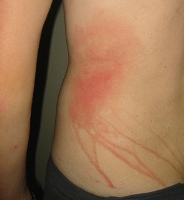Australian long-distance swimmer Chloe McCardel was forced to abandon her attempt of being the first person to swim from Cuba to Florida without a shark cage when she was stung by a swarm of jellyfish. She described the pain as “explosions hitting my body” and was paralyzed from waist down by the pain of the numerous stings she obtained. Although she was stung repeatedly on the different parts of the body by the tentacles of the Box jellyfish, McCardel kept going for 20 to 30 minutes. She was finally removed from the water when crew members saw her removing a tentacle from her face and mouth.
Jellyfish thrive in the cold and warm water of the ocean, and even along the coastlines. These jellyfish contain stinging cells in their tentacles that are filled with poison (venom) that stun and/ or paralyze their prey before consuming them. Their stings can be painful to humans, possibly dangerous and sometimes be deadly. Jellyfish stings with short tentacles do not often cause pain to humans. But it must be noted that even dead jellyfish are capable of stinging. However, these jellyfish do not attack humans on purpose, usually only when people accidentally come into contact with them. The most toxic species of jellyfish to human is the Australian box-like sea wasp.
There are several symptoms of jellyfish sting, usually immediate intense, stinging pain, characterized by itching, rash and raised welts. The more serious effects of jellyfish sting may include nausea, vomiting, arrhythmia, swelling of lymph nodes, abdominal pain, diarrhea, tingling sensation or numbness and muscle spasms. Severe reactions may lead to difficulty in breathing, coma and even death. Stings from venomous types of jellyfish may lead to deaths in a few minutes. Unlike bee stings, jellyfish tentacles keep stinging as long as they are in contact with the skin.
Most jellyfish stings can be remedied at home. Call for emergency
medical services if severe symptoms are observed. If possible, wear gloves. Use tweezers or clean stick to remove remaining tentacles. The affected area should be soaked in vinegar for 15 to 30 minutes to avoid he toxins from being released. If no vinegar is available, wash the area with alcohol or seawater, neither hot nor fresh cold. Do not apply ice or rub the area. Although it is a popular myth, urine should not be poured on the injured area because it may cause further damage the affected area. To remove any remaining nematocysts, or small poisonous sacs, that are stuck to the skin, apply shaving cream and use a razor blade or credit card.
If stung by a Portuguese man-of-war, a type of jellyfish, the same
treatment should be used as mentioned above. However, vinegar or alcohol cannot be used to rinse the affected area as it may worsen the pain. The pain usually lasts for only 15 to 20 minutes but if the pain lingers for an hour or if infection occurs, seek medical help immediately.
First aid training can be taught to swimmers, beach lovers and divers who want to learn remedies for jellyfish stings and other emergencies which can occur in the coastline or in the ocean.
